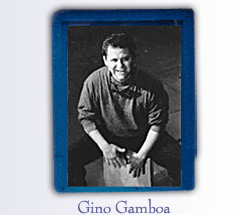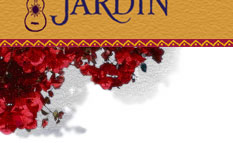 |
|
Updating
and reinvigorating the lively son jarocho of Veracruz,
Mexico, Los Angeles-based Conjunto Jardín (cone-HOON-toe
har-DEEN) features sisters Libby
and Cindy Harding
– the band’s name is a play on the Spanish pronunciation
of their last name – on the traditional jarana,
a small strummed rhythm guitar, and requinto, a 4-string
lead guitar plucked with a long bone pua or pick.
(Thus the expression “I’ve got a bone to pick
with you.”) Their sibling vocals ride atop hard-charging
jaranas, driving cajón-and-bass rhythm section
and sparkling harp-like keyboards to create a fresh, modern
sound that is at once faithfully traditional, yet at the
same time possessed of a rock-influenced drive and accessible
edge. The group was nominated for Best Latin/Salsa
Artist in the 2003 L.A. Weekly Music
Awards, and is the recipient of an L.A.
Treasures Award from the City of Los Angeles
Department of Cultural Affairs.
Their long-awaited third album, Yerba Buena, was
released May 5, 2008. It features an expanded palette of
sounds and rhythms – including quena (Andean flute),
zamponas (bamboo panpipes), accordion, organ and other electric
keyboards, electric guitar and rock- and Colombian vallenato-inspired
grooves – as the group continues to expand the borders
of son jarocho. The extraordinary artwork and package design
is by young Chicano artist Daniel González. See
Recordings.
Cindy and Libby ("La Xeminita Hendrix" and "La Bruja", respectively)
started playing jarocho music as children, learning from
and performing with their father, renowned Latin American
scholar and musician Timothy Harding (“El
Gran Tigre”), and his group Los Tigres de la Sierra.
They have further honed their skills with trips to Veracruz
and by studying with master jarocho musicians in Mexico
and the U.S. Both played key roles in seminal ’80s nueva
canción group Sabiá: Cindy co-founded
the ensemble while at Brown University in 1976, and Libby’s
original songs and “deceptively delicate” lead
vocals defined the band’s core sound. After singing
together for more than 25 years, the sisters achieve
that special vocal blend unique to siblings. And La Ximenita
is still the only known woman requinto player!
Around the traditional core of jarana and requinto, Conjunto
Jardín features keyboardist Gary
Johnson (“El Pulpo”) on “incredible
keyboard-harp simulations” (Tom Cheyney, L.A. Weekly),
as well as quijada de burro (donkey jawbone), pandero
(large wood-framed tambourine) and jarana. The native Oklahoman
but longtime L.A. resident’s varied musical résumé
includes Del Shannon (yes, he got to play the famous “Runaway”
proto-synth keyboard solo), the Rick Vito Band with Russ Kunkel
and Bob Glaub, Robben Ford, the Bonedaddys, Steve Ripley,
Fast Fontaine, Sabiá, Word of Mouth, Michele Greene,
Ritmo Mela’o, the Ciro Hurtado Group, and Blue Rose
Café (with Kevin Welch) among others. El Pulpo has
worn many funny hats on stage. This makes one more.
Connecting the dots from Veracruz to Cuba and back to Africa
is Marcel Adjibi
(“El Capitan”) from Benin, West Africa, on cajón
– the wooden box drum originated by black slaves in
the Americas – talking drum, chekere and vocals. His
surging crescendos and African vocal touches add a below-the-waist
rhythmic sway that makes tangible what’s often debated
by scholars of son jarocho: the genre’s African roots.
(“La Bamba” was written by an African ex-slave
in the 1800s.) His professional career has taken El Capitan
from Ivory Coast and Senegal to Paris, Washington, DC and
Los Angeles, featuring stints with Manu Dibango and Aster
Aweke among others.
With Marcel now a part-time member following a move to Texas
in 2006, Conjunto Jardín now benefits from the estimable
contributions of master Peruvian cajonero Gino
Gamboa ("El Obispo").
Bass player and Kansas City native Rick
Moors (“El
Tiburon”) has worked with Oleta Adams, Mary Wells, Combonation,
and Ritmo Mela’o among many others. As long-time bassist
for the Bonedaddys, he has been playing world music (and wearing
silly outfits on stage) since before it had a name.
Chiapas, Mexico native Jorge Mijangos (“Shpococ”)
sings and plays jarana, leona (a baritone requinto that
functions primarily as a bass), Cuban trés and
percussion. Disgustingly talented, Jorge can play just
about any instrument. Jorge is also a master luthier and
builder of many of the band’s instruments. Learn
more about Mijangos instruments here.
(La Bruja: “We weren’t sure if we could allow
a Mexican in the group, but Shpococ was studying with my
father (‘El Gran Tigre’), so we decided it
was OK.”)
Many Conjunto Jardín shows also feature elegantly
costumed virtuoso dancers Luis and Maritonia Garcia of
the Club Veracruzano de California, masters of the region’s
electrifying and percussive zapateado dance style.
The group’s second CD, Floreando (Flowering)
(Trova Recordings 2003), received excellent reviews and spent
much of spring 2003 in the top 10 on CMJ’s
Latin Alternative airplay chart. It was inspired by the band’s
2001 trip to Tlacotalpan, Veracruz, Mexico, to participate
in the annual Encuentro de Jaraneros (literally, “meeting
of jarana players” – the major annual festival
of jarocho music and dance) where they were a surprise hit
of the festival, according to prominent Mexico City daily La Jornada. Floreando attempts
to bridge the gap between the two principal schools of jarocho
music, combining the rhythmic drive and virtuosic sparkle
associated with the port city of Veracruz with the roots-oriented
and percussion-flavored style typical of the region’s
rural areas. See reviews for Floreando here.
Putumayo World Music’s 2001 compilation Music of Mexico features “La Bruja” from
Conjunto Jardín’s well-received first CD, Nuevo
Son Jarocho (1998, Trova Recordings). See reviews for
Nuevo Son Jarocho here.
Since Conjunto Jardín’s successful
1997 debut at L.A.’s John Anson Ford Theatre, the group
has gone on to bravura performances at universities, concert
series, festivals and clubs, including a 1998 CD release concert
at California Plaza Grand Performances for an audience of
3,000, supporting Carlos Vives at a sold-out House of Blues
– for which they garnered a full-page review in Los
Angeles Spanish-language daily La Opinión,
with enormous color photos – and a SRO Cal Poly San
Luis Obispo concert with Cesaria Evora.
In September 2002, the Fandango Jarocho gala at L.A.’s
John Anson Ford Amphitheatre finally presented in an appropriate
setting two of the most important groups, in both artistry
and celebrity, in the resurgence of jarocho music in Veracruz:
Son de Madera and Mono Blanco. Conjunto Jardín was
honored to be a part of this concert, and their set’s
preview of material from Floreando elicited a response
from the audience fully as enthusiastic as that shown the
illustrious out-of-town guests.
In April 2004, Conjunto Jardín
participated in the 3rd annual Encuentro de Jaraneros de
California. Libby Harding was one of the principal organizers
of this groundbreaking event that drew 1,000 jarocho aficionados
and curiosity-seekers to the plaza at Olvera Street for
more than 8 hours of nonstop jarocho (and a little huasteco)
music. Tim Harding and legendary harp maestro Alberto de
la Rosa both sat in with Conjunto Jardín,
just before Tim was honored for his contribution to the
teaching and diffusion of son jarocho in the U.S.
Conjunto Jardín has participated
in every annual Encuentro de Jaraneros de California. Their
performance at the 7th annual festival, to tale place May
31, 2008, will celebrate the release of the group’s
third album, Yerba Buena.
Part of a resurgence of interest in jarocho music gathering
momentum on both sides of the border, Conjunto Jardín
is on the California Arts Council Touring Program roster,
and is also a CAC Multicultural Artist Program grant recipient.
Son jarocho,
one of the most vital and energetic styles of Mexican folk
music, comes from the state of Veracruz on the Gulf of Mexico.
A key port for five centuries, the city of Veracruz was the
point of entry for cultural influences from Africa and the
old world. This vibrant musical style has roots in Mexico’s
three cultures – Spanish, African and indigenous.
|
 |
 |
 |
 |
| |
 |
 |
|
“... a stunning neo-traditionalist performance
... vocally rich harmonic delivery with an infectious
dance-happy energy ... sterling sonic reflection
and impeccable musicianship ... ¡Vámonos
al jardín!”
– Chuy Varela, Latin Beat |
|
 |
| |
“Without
denying tradition, this postmodern treatment of
the century-old son jarocho deserves taking off
one’s hat, throwing it to the ground and
dancing to the rhythm of the group of jarana-playing
Harding sisters...”
– Ricardo Camerena, La
Opinión |
|
 |
| |
“...
hands-down, the liveliest of Mexico’s folk
string-ensemble traditions. Some listeners may
recognize the genre’s lyrical strains from
the work of Los Lobos, but since 1997, Conjunto
Jardín has been the music’s most dedicated
North American proponent ... The unsuspecting listener
may be surprised to learn that the sextet boasts
only one Mexican musician, the balance hailing
from the U.S. and Benin. But that footnote takes
nothing away from the remarkable work of a band
that rightfully earned rave reviews for its recent,
invited appearance at the annual world summit of
jaraneros in Tlacotalpan, Veracruz ... [S]imultaneously
honors the son jarocho’s inspirational source
and celebrates its efflorescent multicultural future.”
– Michael Stone, fRoots |
|
 |
|
|
|
